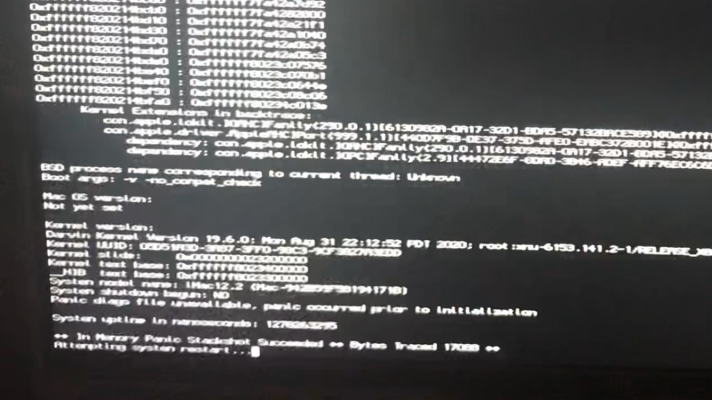- Joined
- Jun 2, 2011
- Messages
- 134
- Motherboard
- Gigabyte GA-P67A-UD4-B3
- CPU
- i7-2600K
- Graphics
- RX 560
I have been working to get AHCI working on my Catalina installation. I tried installing AppleAHCIPort.kext to \L\E\ and then tried SATA-unsupported.kext to \S\L\E\ as recommended in several posts. I used KextBeast to install them. I also added some AHCI patches along with the kexts. The kext+patches seem to have fixed my High Sierra AHCI. While neither of these seemed to cause problems at first with Catalina (I booted/ran a few times), I eventually reset my NVRAM and rebooted, and Catalina no longer boots at all. I have not been able to recover it despite several efforts.
I get this KP error: Panic diags file unavailable, panic occurred prior to initialization, with backtrace to AppleAHCIPort. (see attached)
I booted into my working High Sierra to remove the offending kexts, figuring that would resolve the boot KP. Removing AppleAHCIPort.kext didn't seem to fix the issue (even after resetting NVRAM). So, I went looking for SATA-unsupported. But I couldn't find it. I read somewhere that it may not install (easily) due to permission issues, so maybe it just never got installed? It isn't listed in the KP, so maybe it isn't the problem (even though it was the last thing I installed).
I have a clone of the Catalina installation, so I could wipe it clean and start over, but I wanted to try to fix this as a learning experience. I expect it is something rather simple once I know what to do. It seem that having the kext there, the system is not able to read the file or something - so maybe it is a permission issue where KextBeast messed up the folder in a way that is more than just the kext file? I haven't dealt with installing kexts onto my system drive, and don't fully understand how permissions/caches/nvram/etc interact.
Please advise what steps I should take to diagnose and fix this KP on startup. Thanks
I get this KP error: Panic diags file unavailable, panic occurred prior to initialization, with backtrace to AppleAHCIPort. (see attached)
I booted into my working High Sierra to remove the offending kexts, figuring that would resolve the boot KP. Removing AppleAHCIPort.kext didn't seem to fix the issue (even after resetting NVRAM). So, I went looking for SATA-unsupported. But I couldn't find it. I read somewhere that it may not install (easily) due to permission issues, so maybe it just never got installed? It isn't listed in the KP, so maybe it isn't the problem (even though it was the last thing I installed).
I have a clone of the Catalina installation, so I could wipe it clean and start over, but I wanted to try to fix this as a learning experience. I expect it is something rather simple once I know what to do. It seem that having the kext there, the system is not able to read the file or something - so maybe it is a permission issue where KextBeast messed up the folder in a way that is more than just the kext file? I haven't dealt with installing kexts onto my system drive, and don't fully understand how permissions/caches/nvram/etc interact.
Please advise what steps I should take to diagnose and fix this KP on startup. Thanks

